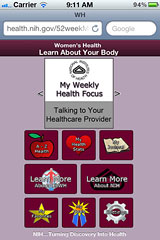Office of Women's Health
The mission and work of the Office of Women’s Health (OWH) is guided by the overarching theme, “To improve the health, wellness and safety of women and girls across the lifespan through policy, programming, outreach and education.”
OWH coordinates women’s health-related activities across HRSA, strengthening the programmatic focus to reduce sex and gender-based disparities and support comprehensive, culturally competent, and quality health care. OWH’s goals are to:
- Provide leadership on policy and programs;
- Expand access to quality health services, education and community-based interventions; and
- Support mentorship and lifelong learning opportunities.
Selected cross-cutting, activities supported by OWH include:
Supported Activities
Among the activities HRSA OWH supports are the following:
Bright Futures for Women's Health and Wellness is an initiative to plan, develop, implement, and evaluate a variety of evidence-based, culturally competent consumer, healthcare provider, and community products that will increase women’s awareness and use of preventive health services.
Women's Health USA Databook is an annual reference publication summarizing key statistics on health indicators by sex, race/ethnicity, and age. It is developed in partnership with the Maternal and Child Health Bureau’s Office of Epidemiology, Policy, and Evaluation and the Bureau’s Division of Healthy Start and Perinatal Services.
State Women's Health Profiles provide each U.S. State and jurisdiction's women's health-related priority needs, State performance and outcome measures, and additional women’s health-related data supplied by States in the 2010 Title V 5-year needs assessments.
National Women’s Health Week
National Women’s Health Week is an annual event that takes place during the week following Mother’s Day each year in May to recognize the importance of improving the health and well-being of women across the country. Families, communities, businesses, government, health organizations and other groups work together to focus on healthy lifestyles and simple action steps.
Violence Prevention
Violence prevention is one of the office’s top priorities and efforts are underway to raise awareness through collaboration with HRSA Bureaus and Offices, other HHS agencies, and external partners. Current activities include providing violence prevention updates and technical expertise on the behavioral impacts of trauma affecting women and girls to identify gaps, and recommendations for systems change, integration, and collaboration. The office also coordinates the Violence Prevention Workgroup (VPW) through the HRSA Women’s Health Coordinating Committee (WHCC) and other partners to coordinate violence prevention-related activities and national health observance events. In 2011, the VPW led efforts to revise the HRSA Workplace Violence Prevention Policy and partnered with the HRSA Learning Institute to implement a mandatory annual training for employees.
September is Ovarian Cancer Awareness Month
In 2012, the estimated ovarian cancer cases and deaths in the US is 22,280 and 15,500, respectively. Ovarian cancer causes more deaths than any other type of female reproductive cancer and most deaths from ovarian cancer occur in women over the age of 55. Risk factors include women who have; a mother, daughter, or sister with ovarian cancer; a family history of cancer of the breast, uterus, colon, or rectum; a personal history of cancer such as breast, uterus, colon, or rectum, and have never been pregnant.
October is Breast Cancer Awareness Month
Breast cancer can occur in both men and women, however, male breast cancer is rare. In 2012, the estimated breast cancer cases and deaths in the US are 226, 870 (female); 2,190 (male); and 39,510 (female); 410 (male), respectively. There are several risk factors for breast cancer in women including, but not limited to age, reproductive and menstrual history, personal history, family history, and race.
Recommended screening can help detect several forms of cancer in early, more treatable stages, including breast, colorectal, and cervical cancer, and is shown to reduce mortality.
Sources:
National Cancer Institute: Breast Cancer
National Cancer Institute: Ovarian Cancer
National Library of Medicine - PubMed Health: Ovarian Cancer
52 Weeks of Women's Health –
get the app from the National Institutes of Health.


